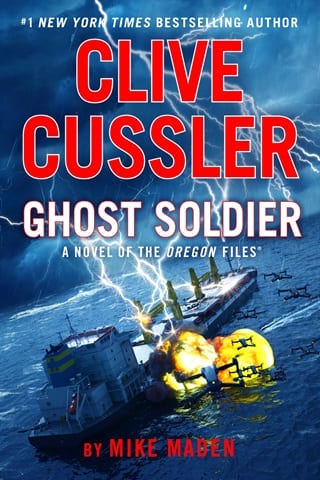Chapter 67
67
Pau Rangi Island
The Bismarck Sea
The Vendor stood in a vaulted cavern deep beneath the island, its rocky escarpments carpeted with windswept trees and verdant foliage. Water gently lapped behind him.
The sharp tang of incense muted the smell of the sea inside the cave, but that was not its purpose. The thin tendrils of smoke and its alluring aroma were an invitation for his ancestral kami to visit him.
The Vendor bowed twice, clapped his hands sharply, and bowed again before gazing up at the kami-dana—his ancestral shrine—lodged in a hand-hewn niche on the cave wall. A small saucer of freshly poured sake, a lit candle, and three talismans—a war medal from each grandfather, and his father’s circular slide rule—all stood before the head-sized mirror inside the shrine.
The mirror itself was angled downward such that when the Vendor stood at his full height and gazed into it, he saw his own face. This was not ego. The mirror reflected the presence of his ancestors. Was not his own face a reflection of the same? Yes, and in more ways than one.
The flesh on the back of his neck tingled, making their presence known.
Shigeru Hashimoto, also known as the Vendor, whispered thanks to his forefathers for his narrow escape from the Island of Sorrows and his safe return to Pau Rangi. He also begged forgiveness for his obvious failures, and renewed his vow to finish the work they had begun: Operation Black Chrysanthemum. Designed to kill thousands of Americans, it was both a strategic weapon and an act of pure vengeance.
Hashimoto’s hatred for Mendoza and the crew of the Oregon was deeply personal. But his hatred of all Americans was an epigenetic phenomenon in Hashimoto’s family, passed down the generations. Decades of simmering enmity merged with the genetic endowment and spiritual evolution of his bloodlines.
His maternal grandfather, Dr. Yoshio Mitomo, had developed the original neurotoxin formula while serving at Unit 731. His dutiful grandson had now perfected that formula and would soon unleash it. His grandfather’s hatred for the Americans was kindled during World War II, by all the Japanese lives sacrificed on the altar of so-called democracy. All those fires that burned hundreds of thousands of innocent Japanese civilians alive had their origins on the bomber bases on Guam.
Operation Black Chrysanthemum had been designed to neutralize Guam with an aerial attack with neurotoxins from an I-400–class submarine, which featured an onboard plane hangar. But the Americans sank the submarine before it could complete its mission, and the neurotoxins were lost to the sea.
Surrendering to the Americans, his grandfather Mitomo had been granted immunity from war crimes trials when he agreed to participate in Operation Paperclip, as had so many other high-value German and Japanese scientists after the war.
His paternal grandfather, Hiroshi Hashimoto, had served the Empire as an aeronautical engineer with Mitsubishi, helping to develop Japan’s first jet fighter, the J8MI Shusui—a near replica of the German Komet. He likewise received a pardon for his participation in Japan’s war industry. The Americans transferred his skills to the private sector in order to help build up Japan as a bulwark against communist aggression in the Far East.
The Vendor’s own father had also been an aeronautical engineer, and it was standing by his elbow as a child that young Shigeru Hashimoto learned to love both the aesthetic beauty and mathematical purity of war machines.
Now, standing before the altar of his kami and on the brink of his greatest achievement, Hashimoto knew he would not fail his ancestors, nor would they fail him.
★Hashimoto finished his prayers.
Seawater gently chucked against the hull of the submarine berthed behind him. Inspired by the I-400 series of the Imperial Japanese Navy, the AI-guided vessel could carry 120 high-speed drones all designed to disperse the neurotoxin. The vessel incorporated all of the latest stealth technologies that either absorbed or reflected sonar detection, including an ultra-low-profile sail and continuous curvature hull geometry that mimicked fifth-generation fighter aircraft design. Combined with its hydrogen-fuel, cell-powered electric motors, it was nearly impossible to detect by any electromagnetic means. Once launched, it would reach its target without fail. He named the vessel Ghost Sword.
Hashimoto was supremely confident in the ability of his drones to reach their targets and disperse their fatal payloads. The drones themselves were AI-piloted, capable of making independent decisions. They also deployed the same advanced radar countermeasures that the Chinese drones possessed—countermeasures that he himself had pioneered.
Better still, one of his network colleagues embedded within the Chinese navy had secured the results of their latest drone incursion against Guam. He passed all of the points of vulnerability to Hashimoto, who loaded them directly into the drones. But those points of vulnerability would soon be wiped out when the island’s Enhanced Integrated Air and Missile Defense system came online in less than two days.
Hashimoto’s technicians had promised him that as soon as the batch processing of the neurotoxin was complete, it would take only six hours to fill the dispersion tanks and set into the drones. After that, the drone launch pods could be loaded into the Ghost Sword.
Right now, the giant countdown clock on the cave wall read 22:07:14. That was the absolute last moment the Ghost Sword could set sail and hope to reach its drone launch point.
The challenge now was finishing the batch processing of the neurotoxin. They were still on schedule, but any glitch in the complex procedure would throw everything into disarray and would require a complete restart. And such a restart meant total failure.
Hashimoto stood at the elevator that would take him directly to the lab. His temptation was to unleash a fresh torrent of threats against his people to insure they met their deadline. But the voices in his head told him to steady himself. He had recruited some of the best scientists in the world for the task. Besides, he had already promised them excruciating punishments for failure and the promise of untold wealth if they succeeded.
By the time the elevator door slid open, Hashimoto had becalmed himself. A delicate, fatherly hand was all that was needed. He would simply observe and compliment his people, and allow his own supreme confidence to motivate them to greater glory.
His plan was perfect. Black Chrysanthemum would not only disable all of the military facilities on the island but also kill the one hundred eighty thousand Americans stationed and living there. This would hardly be enough to balance the scales of justice. But those deaths would only be the beginning. A full-scale war between the United States and China, Japan’s other most hated nemesis, would lead to the death of millions.
Hashimoto had built the toxin-unleashing stealth drones to Chinese military specifications, which he knew well since he had been the one to design them. His mission drones were all built with Chinese parts, Chinese computers, and Chinese computer chips. He also did all of the programming in Chinese script. They would access China’s version of GPS, the BeiDou Navigation Satellite System (BDS), during flight. Best of all, he had programmed one of the drones to crash on the island so that it would be discovered, and all of the false clues uncovered.
Coupled with the fact the overly aggressive Chinese navy had been running various sorties against Guam for the last several weeks, any reasonable intelligence analyst would conclude that China had been the source of the treacherous drone attack. War would ensue, and the Vendor would stand to profit handsomely from the resulting chaos.
Better still, he and his kami would finally savor the sweet taste of ultimate and bloody revenge.
Hashimoto smiled to himself as he stepped into the elevator, feeling the flesh on the back of his neck tingling once again.
 Fullepub
Fullepub 



